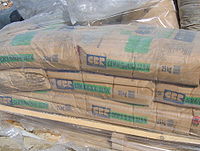
Photo from wikipedia
Portland cement tends to exhibit negative environmental impacts; thus, it is required to find measures that will improve its green credentials. In this study, we report a blended Portland slag… Click to show full abstract
Portland cement tends to exhibit negative environmental impacts; thus, it is required to find measures that will improve its green credentials. In this study, we report a blended Portland slag cement as an alternative environmentally-friendly building material in order to reduce the total carbon footprint resulted from the production of the ordinary Portland cement (OPC), which may resolve the environmental issues associated with carbon dioxide emissions. The ordinary Portland cement type I enhanced by basic oxygen steelmaking slag (BOF) is produced and casted into cubic and beam-like samples for the compressive and three-point bending tests, and the compressive and flexural strengths are experimentally measured. Numerical simulations are conducted to compare with the experimental result and satisfactory agreements are obtained. X-ray diffraction (XRD) investigations and porosity tests are then carried out using the semi-adiabatic calorimetry, which indicates that 5% BOF is the optimal ratio to accelerate the hydration process while increasing the amount of hydration products, especially at the early curing age of 3 days. Scanning electron microscope (SEM) images further indicate that BOF can be used to prevent the development of microcracks while mitigating their propagation within cement mortar. Our study indicates that the compressive strength of OPC can be critically increased by BOF at the relatively low concentrations of 5%. The blended slag cement reported in this paper provides advanced understanding on the green building material that uses byproduct wastes for the mechanical and electrical performance.
Journal Title: Materials
Year Published: 2020
Link to full text (if available)
Share on Social Media: Sign Up to like & get
recommendations!